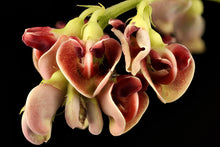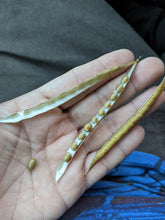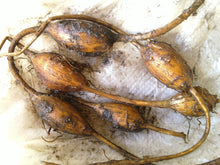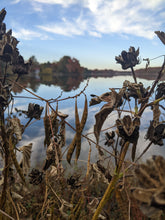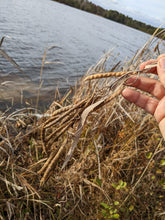South Jersey Hopniss (American Groundnut)
Regular price
$5.00
Sale
Apios americana
Origin: New Jersey
Improvement status: Wild
Seeds per packet: ~18
BOTANICAL SAMPLE - NOT GERMINATION TESTED
Life cycle: Perennial
You asked — repeatedly — and we're finally able to deliver: Apios americana seeds for all!!!
Called hopniss (or hobbenis) by the Lenape people — whose homeland stretches from the modern state of Delaware north to western Connecticut, including the entire state of New Jersey, where these seeds were foraged — and also known as American groundnut, potato bean, cinnamon vine, and America-hodoimo (in Japan), this perennial legume sustained indigenous peoples across eastern North America for untold generations. Grown commercially in parts of Japan and Korea, it has yet to catch on in the land to which it is native — but with the increased popularity of native edible plants, and especially perennial edibles, that may soon be changing. We hope by offering these seeds, we're contributing to that process.
Hopniss is a vining perennial legume found from just east of the Rocky Mountains to the Atlantic coast, and from Florida well into Canada. It generally favors a wet habitat like the edge of a pond or lake. It can climb up to twenty feet in a season, but dies back to the ground each winter. Its burgundy-colored flowers are beautiful and distinctive (and delicious batter dipped and fried!).
Scientists tell us that there are two forms of hopniss, a diploid form that is capable of producing seeds (which are tan and blocky little beans) and a triploid form that can only flower, but never produces seeds. These triploid forms mainly exist in the northern part of its range, from Pennsylvania northward. New Jersey is something of a dividing line, so these seeds come from some of northernmost seed-producing plants.
But it's not the seeds that most people are after — though they are edible and delicious, if small — it's the "groundnut," the tubers that grow along rhizomatous underground stems. With a similar flavor profile to potatoes (though nuttier, sometimes beany or peanuty), they are adaptable to range of different preparations: roasting, steaming, sauteeing, drying and grinding into flour, candying, fermenting, and on and on. But while they may resemble potatoes, they are also nutritional powerhouses, with three times the protein (16.5%), twice the iron, and ten times the calcium. They also have a balanced amino acid profile and are loaded with isoflavones known to have anti-carcinogenic effects.
The tubers of hopniss plants vary greatly in size and shape, which is part of what has kept this crop from being cultivated beyond a few localized areas in East Asia (to which it was introduced over a century ago). Concerted efforts to domesticate the plant in the United States were initiated in 1985 under the direction of Dr. William J. Blackmon and Dr. Berthal D. Reynolds along with other colleagues at Louisiana State University in Baton Rouge. Wild hopniss tubers might be found three feet from where the vine emerges from the ground, in any direction, with six or more inches between tubers, which are found strung along rhizomatous stems. They also take two years to reach a size worth harvesting. So the LSU program had multiple goals, including to develop varieties with larger tubers, dense tuber set, single-season production, and productivity when grown without a trellis. Between 1985 and 1994, the Blockmon team collected over 200 wild accessions, produced over 2,200 hybrid lines, and after evaluation saved 53 of these for further analysis. Eventually, Dr. Blackmon retired and the hopniss breeding program at LSU ceased to exist, but thankfully much of that work has been saved, and today the largest collection of improved hopniss is maintained by Iowa State University professor (and longtime friend of EFN!) Dr. Steven Cannon. Our friend Alex Wenger at Field's Edge Research Farm in Pennsylvania is also doing important breeding work with hopniss. We are happy to also be selling some hopniss tubers this year that trace their roots back to Dr. Blackmon's breeding program, produced by EFN grower Michael Billington in Montana, but we are equally excited to be offering these seeds, since each one has the potential to become a new cultivar that could be worthy of a name and clonal propagation in perpetuity.
A nitrogen-fixing perennial legume with edible seeds and nutritious tubers. What more could a polyculture-loving agroecologist want?!
These seeds were foraged from the wild in Salem County, New Jersey, by EFN co-founder Nate Kleinman.
GROWING TIPS: Start seeds in flats around the last frost date, or direct-sow a few weeks later. Some sources suggest cold stratification or fall sowing for best results, but we have had little trouble getting at least some hopniss seeds to germinate without pre-treatment. We recommend starting these seeds in flats unless you have a very well-prepared, weed-free bed and you're prepared to keep close watch over them as they grow. The young plants grown from seed are a bit spindly and inconspicuous, so easy to get lost among weeds. Once established, plants benefit from a trellis or something else to climb on. There are historical reports of Indigenous peoples growing them in a polyculture system with other plants, including corn and squash — offering a perennial third-sister alternative to common beans — though we have yet to try this method. You might try digging up some tubers at the end of the first season, but you are likely to have much larger tubers after year two or three. And if you find any with particularly large tubers, clustered tightly together, please get in touch with us because we want more like that!
NOTE: We didn't dig any of the tubers from the plants that provided these seeds. Photo of tubers is from Malte CC BY-SA 3.0






